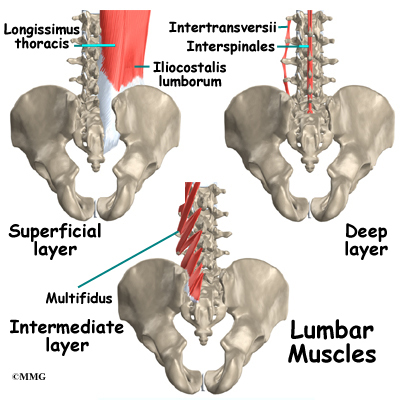Muscles Of The Lower Back | In this image, you will find an occipital bone, sternocleidomastoid, trapezius, deltoid in muscles of the lower back diagram. Other muscles in the region are usually involved as well, such as the gluteus maximus, piriformis, and the lumbar paraspinal muscles. The hip muscles encompass many muscles of the hip and thigh whose main function is to act on the thigh at muscles: Gluteus medius this muscle is a major generator of lower back and hip pain, as well as being responsible for complaints of a burning sensation along the posterior superior iliac spine (psis) and sacroiliac joint. The pelvic floor muscles also help increase this pressure, which provides stability to the spine and trunk.
Key muscles of the hip : The pelvic floor muscles also help increase this pressure, which provides stability to the spine and trunk. 1 this problem occurs as a result of an injury to the back muscles and ligaments that support the spinal column. The muscles that move the upper legs (thigh) there are many muscles that move the large bone of the thigh. Patients may or may not remember the initial event that triggered their muscle spasm, but the symptoms of a lumbar muscle strain can be severe.
Other muscles in the region are usually involved as well, such as the gluteus maximus, piriformis, and the lumbar paraspinal muscles. The erector spinae is composed of three subgroups: This can put extra stress through our lower back and cause pain. By the way, have you heard about the myth of. Posterior view of the erector spinae musculature of the low back. Lower back muscle and hip pain may also be caused by stenosis in the spine. Painting of a woman's back by edgar. Tens of thousands experience relief from pain every month with our unique formula. See back muscles and low back pain. Only the iliocostalis is shown on the right side. All three subgroups are shown on the left side; Safe & effective cold laser therapy make an appointment. All the extrinsic back muscles are innervated by the anterior (ventral) rami of the cervical spinal nerves , except for the trapezius muscle which receives its supply from the accessory nerve (cn xi) .
Muscles found in the superficial group include rhomboid major, rhomboid minor, levator scapulae, trapezius, latissimus dorsi. The extensor muscles are attached to back of the spine and enable standing and lifting objects. Serratus posterior superior and serratus posterior inferior muscles. Safe & effective cold laser therapy make an appointment. The back muscles can usually heal themselves within a couple of weeks, but the pain can be intense and debilitating.

Key muscles of the hip : Serratus posterior superior and serratus posterior inferior muscles. Posterior view of the erector spinae musculature of the low back. Weakness in the trunk muscles can be a cause and/or a result of low back pain. This stretch works your piriformis muscle, which is found deep in your buttocks. This picture also contains humerus, olecranon process of ulna, deep to tendon and so on. They help to bend the back to one side or the other. The extensor muscles are attached to back of the spine and enable standing and lifting objects. We need a strong trunk in order to perform functional tasks everyday. The muscles of the back can be arranged into 3 categories based on their location: In this image, you will find an occipital bone, sternocleidomastoid, trapezius, deltoid in muscles of the lower back diagram. The back muscles can usually heal themselves within a couple of weeks, but the pain can be intense and debilitating. Muscle structure of the lower back three main muscle groups are located in the lower back:
Weakness in the trunk muscles can be a cause and/or a result of low back pain. If our trunk is lacking strength the body may rely on other areas of the body to produce the force or stability we need. Muscles of lower back diagram. Muscle structure of the lower back three main muscle groups are located in the lower back: All the extrinsic back muscles are innervated by the anterior (ventral) rami of the cervical spinal nerves , except for the trapezius muscle which receives its supply from the accessory nerve (cn xi) .
:background_color(FFFFFF):format(jpeg)/images/library/12632/thumbnail.png)
A lumbar strain is the most common cause of back stiffness. Muscle strains and sprains are common in the lower back, because it supports the weight of the upper body and is involved in moving, twisting and bending. Gluteus medius this muscle is a major generator of lower back and hip pain, as well as being responsible for complaints of a burning sensation along the posterior superior iliac spine (psis) and sacroiliac joint. Muscle anatomy labeling 12 photos of the muscle anatomy labeling anatomy muscle labeling arm, anatomy muscle labeling games, human anatomy muscle labeling, human anatomy muscle labeling quiz, muscle anatomy labeling worksheet, human muscles, anatomy muscle labeling arm, anatomy muscle labeling games. The erector spinae is composed of three subgroups: Muscle fatigue, excessive loads, high speeds or poor lifting postures are the most common causes. All of these muscles stem from the heel of the foot through the calcaneal. The extensor muscles are attached to back of the spine and enable standing and lifting objects. As you can see, there are also have a spine of scapula deltoid, triceps brachii, latissimus dorsi. This can put extra stress through our lower back and cause pain. By the way, have you heard about the myth of. While a pulled muscle in your lower back could potentially cause a pinched nerve, this can also be caused by a herniated disc in your spine. Stretching this muscle may help relieve pain and tightness in your buttocks and lower back.
Muscles Of The Lower Back: They help to bend the back to one side or the other.